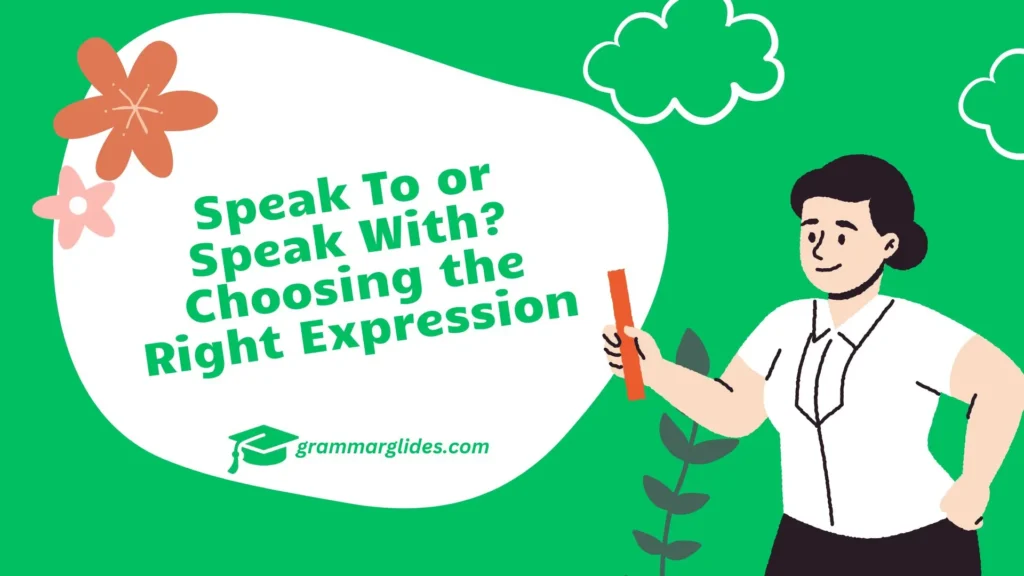“Choosing the right preposition can shape the meaning of your message effectively.”
Prepositions play a vital role in connecting ideas and adding clarity to communication. Among the most common yet confusing expressions in English are “speak to” and “speak with.” Although they may seem interchangeable, their meanings and implications differ based on context, tone, and relationship dynamics.
When communicating, choosing the right expression can strengthen your message. In this post, you’ll uncover the differences between “speak to” and “speak with” and learn to use them correctly.
Understanding the nuances of “speak to” and “speak with” helps you convey the right tone, establish meaningful interactions, and avoid common missteps. This article provides clear explanations, examples, and actionable tips to master these phrases confidently.
Overview: Why Prepositions Matter
Prepositions like “to” and “with” shape how we connect with others in conversations. The choice between “speak to” and “speak with” can indicate the nature of interaction, tone, or formality. Misusing these expressions may lead to confusion or unintended implications. Let’s dive into their correct usage, mistakes to avoid, and real-life applications.
The Role of Prepositions in Communication
Prepositions set the tone and structure of our sentences. They show relationships between ideas, people, or objects, enhancing the clarity and impact of our communication. With “speak to” and “speak with,” understanding their subtle differences is crucial to delivering your intended message effectively.
Focus on “Speak To” and “Speak With”
Definition and Usage of “Speak To”
Scenario: Imagine a teacher giving instructions to her students before a class trip.

Example 1: The teacher spoke to the students about safety guidelines.
Example 2: Sarah spoke to her boss about her upcoming project deadlines.
Explanation: Use “speak to” when one person is doing most of the talking or delivering a message, especially in formal or instructional settings. It emphasizes a one-way flow of information.
Definition and Usage of “Speak With”
Scenario: Picture two friends discussing plans for the weekend.
Example 1: I spoke with my friend about the best places to visit.
Example 2: John spoke with his coworker to brainstorm ideas for the presentation.
Explanation: Use “speak with” to highlight a conversation involving mutual exchange. It indicates equality and collaboration, making it ideal for informal or cooperative interactions.
Key Differences Between “Speak To” and “Speak With”
Nature of Interaction
Scenario: A company manager is addressing her employees during a meeting.
Speak To Example: The manager spoke to the team about performance targets.
Speak With Example: The manager spoke with the team to brainstorm solutions for challenges.
Explanation: Use “speak to” for one-way communication, such as delivering instructions or addressing an audience. “Speak with” signifies mutual dialogue, where both parties actively contribute.
Formality and Tone
Scenario: A professor interacting with a class during a lecture versus a group discussion.
Speak To Example: The professor spoke to the students about the syllabus.
Speak With Example: The professor spoke with the students about their thoughts on the topic.
Explanation: “Speak to” conveys a more formal, authoritative tone, while “speak with” reflects approachability and collaboration.
Perceived Relationship
Scenario: A parent interacting with their child in two different contexts.
Speak To Example: The parent spoke to their child about finishing their homework.
Speak With Example: The parent spoke with their child about weekend plans.
Explanation: “Speak to” implies a hierarchical relationship, where one person directs the other. “Speak with” suggests an equal or collaborative relationship.
“Even though” vs “Eventhough”: Grammar Simplified
Common Mistakes and Misunderstandings
- Using ” with” for one-sided communication.
- Using ” to” for collaborative discussions.
- Interchanging the expressions without considering tone.
- Assuming both expressions are always interchangeable.
- Not adjusting based on the audience.
Incorrect Usage Examples
- She spoke with the audience during her keynote speech.
- I need to speak with the principal about my grades.
- He spoke to his team to ask for suggestions.
Mistakes often happen when the wrong tone or interaction type is implied. For example, speaking to an audience is a one-sided act, while discussing with someone involves two-way engagement.
Impact of Mistakes
Using the wrong preposition can confuse your audience or create unintended perceptions. For instance, saying “I spoke to him” when discussing ideas might suggest a lack of collaboration, which could misrepresent your intent.
Tips for Choosing the Correct Preposition
- Understand the Context
Determine if the interaction is formal, casual, or professional to choose appropriately. - Identify the Nature of Communication
Decide whether it’s one-way (use “to”) or two-way (use “with”) communication. - Consider the Relationship
Assess the dynamic between the participants. “To” is better for hierarchical settings, while “with” suits equals.

- Match the Tone
Use “to” for formal or instructional tones and “with” for conversational or collaborative tones. - Think About the Audience
Choose “to” when addressing a group, like a speech, and “with” for personal discussions. - Observe Native Speakers
Listen to how fluent speakers use these prepositions to learn the nuances of their usage. - Practice Role-Playing
Simulate scenarios and use both expressions to determine which fits better. - Focus on Mutual Involvement
If both parties are actively engaged, “with” is the correct choice. - Avoid Overthinking
Go with what feels natural in casual settings; prepositions often follow instinctive rules. - Double-Check Meaning
After forming a sentence, ask yourself if it conveys your intended tone and interaction style.
Assessing the Situation
Scenario: A teacher addressing students before an exam.
Example 1 : Use “ to” when delivering instructions or announcements.
Example 2: Choose “ with” for discussions or collaborative exchanges.
Explanation: Context matters. Focus on whether the interaction is directive or participative.
Audience Consideration
Scenario: Communicating with a supervisor versus a colleague.
Example 1: Opt for “speak to” when addressing a supervisor formally.
Example 2: Use “speak with” when collaborating with a peer.
Explanation: Understanding the relationship and expectations ensures your tone is appropriate.
Practical Exercises and Examples
Scenario: Role-play different interactions to practice usage.
Exercise 1: Create dialogues where “ to” fits a formal tone, such as giving a speech.
Exercise 2: Write scenarios where “with” reflects a collaborative discussion.
Interactive Exercises
Rewrite these sentences with the correct preposition:
- She spoke to her coworker to exchange ideas.
- The principal spoke with the students during the assembly.
Discuss whether the following situations require “Speak to” or “Speak with.”
Real-Life Scenarios
- A manager spoke to the employees during a presentation.
- Two friends spoke with each other about their weekend plans.
- The teacher spoke to the parents about their child’s progress.
Key Insight
What is the key difference between “speak to” and “speak with”?
“Speak to” emphasizes one-sided communication, while “speak with” indicates mutual discussion.
Can I use “speak with” in formal settings?
Yes, especially when collaboration or dialogue is appropriate, such as meetings or brainstorming sessions.
Does “speak to” always imply authority?
Not always. It can also indicate the formality of the situation, such as giving a speech.
Which is more common in casual conversations?
“Speak with” is more common in informal or friendly contexts.
How can I avoid mistakes with these expressions?
Assess the context, audience, and tone before choosing the right preposition.
Wrap-Up
Understanding the difference between “speak to” and “speak with” can elevate your communication skills, helping you convey messages clearly and respectfully. Always consider the purpose of your interaction: is it directive or collaborative?.
By practicing real-life scenarios and focusing on context, you can confidently choose the right preposition to match your intent and audience. Let every conversation reflect the tone and meaning you aim to share.

Hi! I’m Lauren Reynolds, the author of Grammar Glides. I create easy-to-follow content that helps you master English with confidence. Let’s make learning English simple and enjoyable together!

